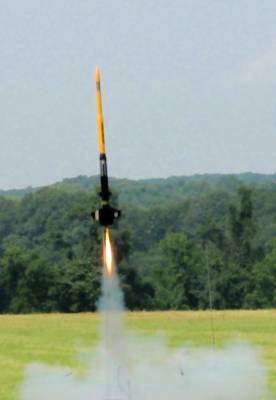The Vector Force: The Vector Force is a modern Estes kit. This was my first model I made as a BAR. It had very good quality balsa fins on my kit, thick and sturdy. You can see the design is inspired by air defense missiles. It is rather tall, but somewhat heavy because of the two reducers. Because it has two reducer stages it has two separate payload tubes. Estes tells you to glue the payload tubes, but why? Good idea if you want to be sure the rocket doesn't separate in flight, but why waste two very nice payload bays? I just make sure they are always good and tight with some masking tape. Mine is painted school-bus yellow and gloss black to better match the included decals. I added about 3 heavy coats of clear coat for a really deep shine. String stability tests with a C motor required about 20-ish grams of nose weight, but now it flies really straight up - provided there is little wind. The top payload tube has vent holes for a barometric altimeter. I've recorded flights in excess of 400 feet with C6 motors. This is my current go-to flagship rocket. I have tried some test flights with composite D engines, to see if I could kick this puppy past 1000 feet. It sure did! In the process, the shock cord was torn out from the mount. This model was repaired by installing a custom ejection baffle with a Kevlar shock cord attachment. Now I think she'll hold up to a few more D-powered launches and ejections. This rocket has flown higher than the NY Times Building in NY, and also the Chrysler Building including the pinnacle, and the Bank of America Plaza in Atlanta.
| Flight Date: | 2011-08-07 |
| Rocket Name: | Vector Force |
| Kit Name: | Estes - Vector Force {Kit} (003210) |
| Flyer's Name: | Rich DeAngelis |
| Motors: | D10-7 |
| Launch Site: | Halifax, PA |
| Actual Altitude: | 1,121 Feet |
First D power for this 18mm bird, and my first composite propellent launch. Fortunately the poor reputation of copperhead ignitors did not show on this flight, the Apogee engine lit on the first attempt. Good takeoff, incredible power! Many, including me, thought it was obviously more than a D, but altitude was as predicted - just over 1000 feet. (Remember the Apogee D10 motor has a lot more total power than an Estes D12.) Ejection was apparently just as powerful, it ripped the shock cord from tape/paper mount and the model seperated into two parts at apogee. The booster landed without a parachute but survived just fine. The parachute melted together in parts, and the payload drifted far under a plastic wad recovery. Will install a kevlar shock cord tied to an ejection baffle, and I already have a nylon chute waiting for this model. Almost afraid to try an Aerotech D21 I have for this rocket (but I'm sure I will). Another rocket in the 1000-high club!
| Stage | Motor(s) |
|---|---|
| 1 | Apogee D10-7 |
 |
 |
